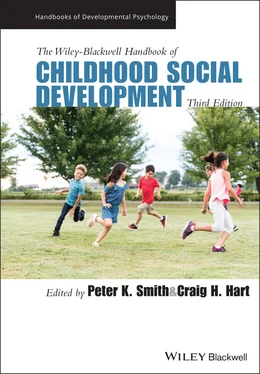The discontinuity hypothesis assumes that the child did not exist until after the Middle Ages. In Medieval civilization there was a negligible difference between the worlds of children and of adults; as soon as the child was weaned, it was seen as the natural companion of the adult. Other historians have found little or no evidence to support this hypothesis. Important research has been done by Hanawalt (1993) which shows that children in London in the 14th and 15th centuries, in many respects, did indeed inhabit a world which was specifically for children and not for adults: they played more than adults, and in separate, safe places; they were part of age groups and had their own, age‐related social environment. Even Ariès himself admitted that his discontinuity hypothesis requires far‐reaching modifications, so far reaching that I would simply conclude that the discontinuity hypothesis is not tenable (for more detailed documentation see Koops, 1996, 1998).
The change hypothesis states that, from about the 13th century, there was a continuous increase in childishness in the cultural representations of children. For this continuous increase in childishness I will use the term infantilization , that is an increasing duration of the childhood stage, which is necessarily accompanied by an increasing distance between the worlds of children and adults (Elias, 1939; Koops, 1998; Plessner, 1946). Much empirical historical support has been gathered for the change hypothesis. Instead of going into the abundant and complex literature, I will illustrate Ariès’ notion of historical changes by referring to a series of paintings. Although Ariès used many types of historical material to support his change hypothesis, it is his interpretation of the child in the world of art that is most controversial. I will briefly illustrate Ariès’ interpretation of children in paintings and refute some of the most persistent academic arguments, which so persistently criticize him precisely on this point.
Ariès argued that up to the 14th century, there are no depictions of children characterized by a special artistic representation, but only images of men on a reduced scale. From around the 14th century onward the Christ child is gradually portrayed as increasingly childish. In the 16th century genre paintings arose in which the child was apparently depicted because of his or her graceful or picturesque qualities. In the 17th century, the modern child was, at last, fully represented in paintings, particularly in Dutch paintings: for the first time there are portraits of children on their own, an intense interest in typical childish scenes is shown, and even family portraits were completely planned around the child. Probably the most dramatic change in the attitude towards the portrayal of children occurred in the 18th century, and generally Rousseau is seen as the advocate of the new stance – not by painting but through his book on the boy Émile. In the 19th century the romantic interest in children even extended to adolescence, which at that time began to take on dramatic forms for the first time in Western History (Koops & Zuckerman, 2003).
Several years ago I made the effort to study the empirical tenability of Ariès’ assertions on children in paintings (Koops, 1996). This was primarily to investigate the most important argument against Ariès’ interpretations, namely that his discussion of some tens of paintings (out of a population of tens of millions of paintings: Koops, 1996; Van der Woude, 1997) certainly cannot be called representative for Western paintings in general. Thanks to a careful and time‐consuming inventory of Dutch and Flemish paintings in which children are portrayed, we were able to draw random samples of paintings which were rated by adults. For the methodology of this research see Koops (1996). In essence we compared the painted images of children with the characteristics of “childish” mammals, as described by the ethologist Lorenz as the Kindchenschema (Child Scheme) (Lorenz, 1971). As decisive features of juvenility that trigger the innate releasing mechanisms for affection and nurturing, he mentions, among other things, a relatively large head, predominance of the brain capsule, large and low‐lying eyes, bulging cheek region, short and thick extremities.
We operationalized Ariès’ change hypothesis so that the infantilization intended by him would mean that images of children in paintings became increasingly childish from the 15th to the 20th century. We predicted that the paintings of children across the centuries would demonstrate a kind of cultural historical neotony. We simply calculated the correlation between the historic dates and the childishness‐scores, based on ratings by adults according to the Kindchenschema ‐criteria. The findings supported the change hypothesis: the correlation was .60, which indicates that paintings in the past emphasized less childishness than modern paintings. This is a surprising and important result, precisely because, contrary to what most historians and in particular art historians claim, it does support Ariès’ interpretation of the paintings.
This research concerning the most controversial part of Ariès’ influential original study shows that we certainly cannot discard Ariès’ view on the infantilization of children as a fable. I therefore consider it important to study the history of pedagogy and developmental psychology, themselves cultural historical phenomena, from an Ariès’ type perspective, rather than from a naive progressive view, as has been the case for too long. The names of Montaigne, Locke, and Rousseau are often proposed as milestones in the progressive modernization of our approach to children. However, instead of a gradual progression in our attitude towards children, supported by science, from my perspective there are culturally and historically changing images of children, of which scientific study is rather the result than the cause (Koops, 1990, 1996, 1998, 2004, 2016).
A most important cultural historical change that in fact ended the process of infantilization is the influence of modern electronic media, actually leading to what could be called the disappearance of childhood.
The Disappearance of Childhood
According to the American culture critic and media specialist Neil Postman (1931–2003), the Western child started to disappear in the early 1960s (Postman, 1992). Following the beliefs of Ariès, Postman observed that without education, or rather without schools, there are no children in the modern sense of the word. After all: “In an illiterate society (like that of the Middle Ages) there was no need to sharply distinguish between children and adults, such a society harbours few secrets, and civilisation does not need to supply education in order to understand itself” (Postman, 1992, p. 22). The notion of the “child” is redundant if everyone shares the same information environment and lives in the same social and intellectual world. In the wake of many media experts and historians, Postman believed that the art of printing created a new world of symbols, which in its turn required a new interpretation of the notion of “adulthood” (Postman, 1992, p. 28).
The invention of the printing press most likely by Johannes Gutenberg (1394–1468) in 1440, resulted in “adulthood becoming a symbolic achievement, not a biological phenomenon. With the invention of the art of printing, children were required to develop, which would be effected by learning to read, by entering the world of typography” (Postman, 1992, p. 43). As a result, children needed education and were compelled to go to school. This made the notion of the “child” inevitable. We can join Postman in observing that this notion had its “finest hour” between 1850 and 1950 (more appropriately a “finest century”). Children had to work in factories as little as possible and were required to attend school. They were given their own clothes, furniture, literature, games, and social world. A process usually called infantilization took place, a historical lengthening of childhood (see Koops, 1998). In contrast, the person who according to Postman is responsible for the “childless era” starting after 1950 is Samuel Morse (1791–1872). Morse’s invention of the telegraph (demonstrated in public for the first time in 1837) further denaturalized information from “personal possession to merchandise of global value.” “Telegraphy marked the beginning of the process of information becoming uncontrollable” (Postman, 1992, p. 74). All this affected the notion of the child immensely.
Читать дальше












